Fundamental material safety
- 01 Air quality standards
- 02 Smoking ban
- 03 Ventilation effectiveness
- 04 VOC reduction
- 05 Air filtration
- 06 Microbe and mold control
- 07 Construction pollution management
- 08 Healthy entrance
- 09 Cleaning protocol
- 10 Pesticide management
- 11 Fundamental material safety
- 12 Moisture management
- 13 Air flush
- 14 Air infiltration management
- 15 Increased ventilation
- 16 Humidity control
- 17 Direct source ventilation
- 18 Air quality monitoring and feedback
- 19 Operable windows
- 20 Outdoor air systems
- 21 Displacement ventilation
- 22 Pest control
- 23 Advanced air purification
- 24 Combustion minimization
- 25 Toxic material reduction
- 26 Enhanced material safety
- 27 Antimicrobial activity for surfaces
- 28 Cleanable environment
- 29 Cleaning equipment
- P9 Advanced cleaning
Fundamental material safety
To reduce or eliminate occupant exposure to lead, asbestos, and polychlorinated biphenyls (PCBs) from building materials.
BACKGROUND
Some hazardous materials, such as asbestos, a known human carcinogen, and polychlorinated biphenyls (PCBs), a probable human carcinogen, are currently restricted or banned in many countries, but are often encountered in older buildings. Others, including lead, remain in limited use. Exposure to asbestos fibers through inhalation can occur when building materials degrade over time or are disturbed during renovation or demolition, and is associated with lung cancer and mesothelioma. Exposure to lead can have neurotoxic effects, even at low levels, and in early development is associated with negative effects on memory, IQ, learning and behavior.

